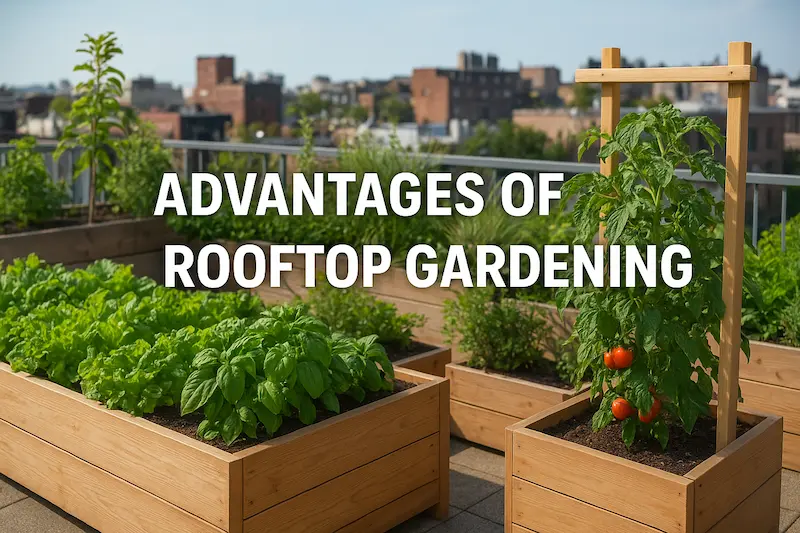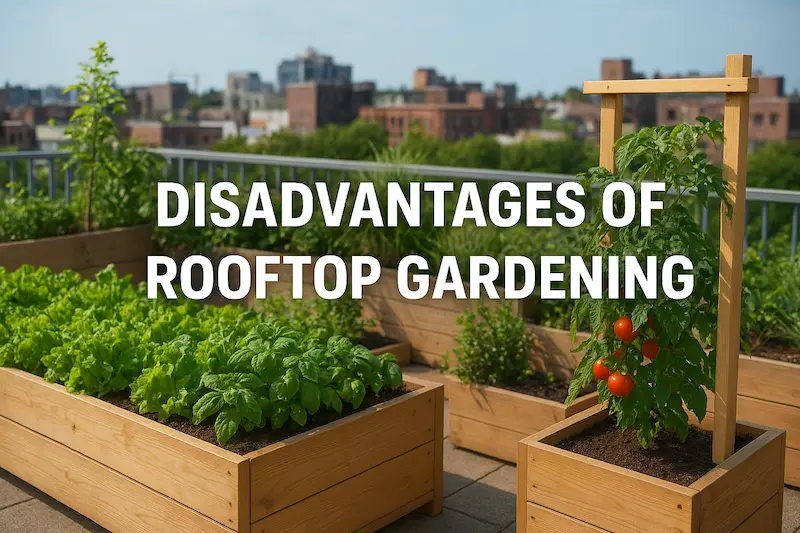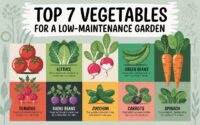Rooftop Gardening: Key Benefits and Challenges for Urban Growers
Published: 2025-10-08
Rooftop gardening is a wonderful way to use the extra space on top of buildings. It allows people living in cities to grow plants, flowers, and vegetables even without a backyard. This modern concept adds beauty to your home while also helping to protect the environment. Many people are turning their rooftops into small green spaces for relaxation and fresh air. In this article, we’ll explore the advantages and disadvantages of rooftop gardening to help you understand its benefits and challenges before you start your own.
What Is Rooftop Gardening?
Rooftop gardening is the practice of growing plants, vegetables, or flowers on building rooftops. It helps reduce heat, improve air quality, and save energy. However, it also has drawbacks, such as high setup costs, maintenance needs, and the potential for water leakage if not properly managed.
So, guys, without wasting time, let’s jump into the article to learn the pros and cons of rooftop gardening.
Advantages of Rooftop Gardening
Rooftop gardening offers many amazing benefits for both people and the environment. It turns unused roof space into a green, relaxing area while improving air quality. These gardens help lower building temperatures, conserve energy, and make cities more aesthetically pleasing. Let’s explore some key benefits of rooftop gardening.

- Utilization of Empty Space
- Reduces Indoor Temperature
- Improves Air Quality
- Enhances Building Beauty
- Reduces Noise and Dust
- Prevents Rainwater Runoff
- Provides Fresh Vegetables
- Saves Energy Costs
- Promotes Relaxation and Mental Health
- Encourages Urban Farming
- Supports Small-Scale Income
- Helps the Environment
- Protects Roof Surface
- Attracts Birds and Insects
- Educational Value
Let us learn the aforementioned benefits of a rooftop garden in more detail.
1. Utilization of Empty Space
The biggest advantage of rooftop gardening is the smart use of unused roof areas. Many city homes and buildings have large rooftops that remain empty. By turning them into gardens, we can make better use of this space and add natural beauty to our surroundings.
- Converts unused roof into a useful space
- Adds greenery to urban buildings
- Reduces heat absorption from the sun
- Creates a relaxing outdoor area
2. Reduces Indoor Temperature
Plants on rooftops help cool down buildings naturally. The soil and greenery act as insulation, reducing indoor temperature. This means less use of air conditioners and lower electricity bills.
- Keeps rooms cooler in summer
- Reduces air conditioning cost
- Improves indoor comfort
- Helps save energy
3. Improves Air Quality
Rooftop gardens play a big role in cleaning the air. Plants absorb carbon dioxide and release oxygen, making the environment healthier for everyone living in the building.
- Purifies polluted air
- Produces fresh oxygen
- Reduces dust and smoke
- Makes urban living healthier
4. Enhances Building Beauty
A rooftop garden changes the look of a dull roof into a beautiful green space. It improves the building’s appearance and makes it more attractive to visitors or buyers.
- Adds natural beauty to the property
- Increases property value
- Makes the building stand out
- Creates a pleasant view from above
5. Reduces Noise and Dust
Green roofs act as a sound barrier and help absorb noise from the streets. They also trap dust particles, improving the overall air quality around the house.
- Lowers noise pollution
- Blocks dust and dirt from entering homes
- Creates a calm atmosphere
- Improves outdoor air quality
6. Prevents Rainwater Runoff
One great benefit of rooftop gardening is that it holds rainwater and prevents it from running off the roof too quickly. This reduces the pressure on city drainage systems and helps in water conservation.
- Controls rainwater flow
- Reduces risk of waterlogging
- Helps recharge groundwater
- Supports eco-friendly living
7. Provides Fresh Vegetables
A rooftop garden gives you access to fresh and organic vegetables right at home. Radishes are fast-growing and compact vegetables, which makes them a good fit for rooftop gardens. Understanding how radishes develop—from germination to harvest—can help you time planting and watering correctly. For a full breakdown, you can read this helpful guide on radish plant growth stages. It gives you clear insights into each phase so your radishes flourish even in limited rooftop space.
- Fresh and organic produce at home
- Saves money on groceries
- Ensures a healthy food supply
- Encourages self-sufficiency
8. Saves Energy Costs
Plants absorb sunlight and reduce heat entering the building. This natural cooling effect helps cut down electricity usage and energy costs.
- Reduces the use of air conditioners
- Keeps the roof temperature low
- Decreases energy bills
- Promotes eco-friendly energy habits
9. Promotes Relaxation and Mental Health
Gardening is known to reduce stress and improve mood. A rooftop garden provides a peaceful escape from daily noise and tension.
- Helps reduce stress and anxiety
- Encourages spending time outdoors
- Improves mood and focus
- Creates a calm and refreshing space
10. Encourages Urban Farming
Rooftop gardening promotes small-scale farming in cities where land is limited. It lets people enjoy the benefits of farming even in apartments.
- Makes farming possible in cities
- Supports local food production
- Teaches gardening skills
- Strengthens community engagement
11. Supports Small-Scale Income
Homegrown vegetables, herbs, or flowers can be sold locally for extra income. Many people turn their rooftop gardens into small home businesses.
- Opportunity to earn from plants
- Reduces household expenses
- Encourages small-scale entrepreneurship
- Promotes eco-friendly business ideas
12. Helps the Environment
Rooftop gardens contribute to a cleaner environment. They reduce pollution, increase oxygen, and help fight climate change by absorbing carbon dioxide.
- Reduces air and noise pollution
- Fights against climate change
- Supports sustainable living
- Protects urban ecosystems
13. Protects Roof Surface
A green layer of plants and soil protects the roof from direct sunlight and rain. This reduces damage and extends the life of the roof.
- Shields roof from harsh weather
- Extends roof lifespan
- Reduces cracks and leaks
- Lowers roof maintenance costs
14. Attracts Birds and Insects
Rooftop gardens attract small birds, bees, and butterflies, adding life to urban areas. This also helps pollination and supports nature balance.
- Creates habitat for birds and bees
- Helps in pollination
- Increases biodiversity
- Brings natural charm to the city
15. Educational Value
A rooftop garden can be a great learning place for children and adults. It teaches about nature, plants, and healthy eating habits.
- Offers hands-on learning
- Encourages children to connect with nature
- Promotes awareness about sustainability
- Teaches basic gardening skills
Disadvantages of Rooftop Gardening
While rooftop gardening has many great benefits, it also comes with a few challenges. Setting up and maintaining a garden on a roof requires proper planning, cost, and care. Some buildings may not support the extra weight or water needs. Let’s look at some common cons of rooftop gardening.

- Roof Strength Requirement
- High Setup Cost
- Regular Maintenance Needed
- Risk of Water Leakage
- Limited Plant Choices
- Weather Exposure
- Difficult Access
- Drainage Issues
- Pest Problems
- Seasonal Growing Limits
- Structural Risks
- Expert Guidance Needed
- Quick Drying of Soil
- Watering Cost
- Permission and Rules
Let us cover all the above-mentioned drawbacks of rooftop gardening in detail.
1. Roof Strength Requirement
Not every roof is strong enough to handle the extra weight of soil, pots, and plants. A weak structure may get damaged over time or develop cracks. Before starting, it’s important to check the roof’s capacity with an expert.
- Needs a strong building structure
- Risk of cracks or roof damage
- Extra cost for reinforcement
- Requires professional inspection
2. High Setup Cost
Setting up a rooftop garden can be expensive at first. It involves buying containers, soil, tools, and installing a waterproof layer. The cost may discourage some people from starting.
- Expensive materials and tools
- Need for waterproofing and drainage
- Professional labor adds cost
- Not budget-friendly for beginners
3. Regular Maintenance Needed
Rooftop plants need daily care, watering, and protection from weather. Without proper attention, plants may dry up or get damaged. Maintenance requires both time and effort.
- Needs daily watering
- Requires weeding and pruning
- Time-consuming for busy people
- Regular checkups for healthy growth
4. Risk of Water Leakage
If the waterproof layer is not properly installed, water can leak into the building. Over time, this can damage ceilings, walls, or electric wiring. Proper planning is needed to prevent this problem.
- Risk of leakage during rain
- Can damage building interiors
- Needs proper sealing materials
- Costly repairs if ignored
5. Limited Plant Choices
Not all plants grow well on rooftops because of limited soil depth and harsh sunlight. Gardeners must select lightweight and shallow-rooted plants.
- Fewer plant options
- Hard to grow deep-rooted crops
- Sensitive plants may not survive
- Affects garden variety
6. Weather Exposure
Rooftop gardens face strong sun, wind, and heavy rain directly. This can harm delicate plants and reduce crop growth. Shade or protection is often needed.
- Exposure to harsh weather
- Damage from strong winds
- Extra care in summer and winter
- Need for protective covering
7. Difficult Access
Reaching the rooftop regularly can be challenging, especially for older people or those with health issues. Carrying soil, water, and tools up the stairs adds more difficulty.
- Hard to climb with materials
- Unsafe for children and elders
- Requires safe access setup
- Time-consuming transportation
8. Drainage Issues
Without a proper drainage system, rooftop gardens can face waterlogging. Excess water can harm plant roots and increase roof damage.
- Standing water harms plants
- Roots may rot easily
- Risk of leakage increases
- Needs proper outlet pipes
9. Pest Problems
Rooftop gardens are not completely safe from pests or insects. Without regular pest control, plants may get damaged quickly.
- Attraction of insects and pests
- Need for pest management
- Affects plant health and yield
- Requires natural or chemical control
10. Seasonal Growing Limits
Rooftop plants are affected by extreme temperatures. Growing crops in very hot or cold weather can be difficult without a controlled environment.
- Limited growing seasons
- Heat and frost damage plants
- Requires shade or covers
- Seasonal dependency on yield
11. Structural Risks
Heavy pots, soil, and water can add a lot of pressure on the roof. If not planned well, this may cause long-term structural damage to the building.
- Extra load on the roof
- Risk of small cracks or sagging
- Reduces roof lifespan
- Needs regular inspections
12. Expert Guidance Needed
Rooftop gardening requires some technical knowledge. Many people may need expert help for design, soil setup, and drainage systems.
- Hard to plan without training
- Experts may charge extra
- Mistakes can cause damage
- Need for initial guidance
13. Quick Drying of Soil
Rooftop gardens face direct sunlight and wind, which dries out the soil faster. Plants may need frequent watering to survive.
- Soil dries quickly
- Frequent watering required
- Stress on plants in heat
- Water shortage risk
14. Watering Cost
Rooftop gardens consume more water due to faster evaporation. This increases the water bill and requires an efficient watering system.
- More water usage
- High water cost
- Need for irrigation setup
- Wastage risk if not managed
15. Permission and Rules
Some cities or apartments have rules about rooftop usage. Without permission, setting up a garden might cause legal or safety issues.
- Need for building approval
- Possible legal restrictions
- Shared roof access problems
- Delays due to regulations
FAQs about Green Roof Advantages and Disadvantages
Here is a list of frequently asked questions about the pros and cons of rooftop gardening.
A rooftop garden helps reduce building heat, improves air quality, and provides fresh vegetables and herbs at home. It also adds beauty to buildings, supports biodiversity, and helps lower energy costs by keeping indoor spaces cooler.
Rooftop rainwater harvesting allows you to collect rainwater for gardening and household use.
Advantages: Saves water, reduces bills, and lowers flood risk.
Disadvantages: Needs proper filters, storage tanks, and regular cleaning to prevent contamination.
Terrace farming makes use of sloped land or rooftops for growing crops.
Advantages: Prevents soil erosion, saves space, and improves water use.
Disadvantages: Requires a strong roof structure, high setup cost, and regular care to avoid water damage.
Green roofs help absorb carbon dioxide, filter dust, and reduce the urban heat effect. They create habitats for birds and insects, reduce stormwater runoff, and make cities cleaner and greener while improving overall air quality.
Conclusion:
In conclusion, rooftop gardening is a smart and eco-friendly practice that brings many benefits to urban life. It helps reduce heat, saves energy, and provides fresh vegetables right at home. At the same time, it requires planning, maintenance, and roof safety checks to avoid problems.
By understanding the advantages and disadvantages of rooftop gardening, if you’re thinking about starting a small rooftop garden, leafy greens like lettuce are a great choice for beginners. They grow quickly and take up little space. You can follow this step-by-step article on lettuce growth stages to understand how to grow healthy lettuce from start to finishyou can make better decisions and create a healthy, green space that improves both your home and the environment.

- Be Respectful
- Stay Relevant
- Stay Positive
- True Feedback
- Encourage Discussion
- Avoid Spamming
- No Fake News
- Don't Copy-Paste
- No Personal Attacks

- Be Respectful
- Stay Relevant
- Stay Positive
- True Feedback
- Encourage Discussion
- Avoid Spamming
- No Fake News
- Don't Copy-Paste
- No Personal Attacks



